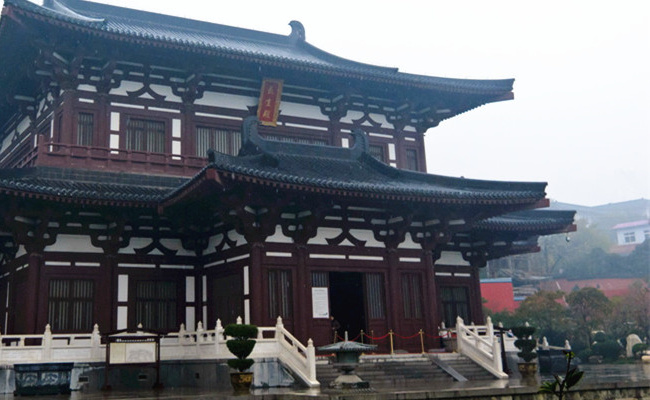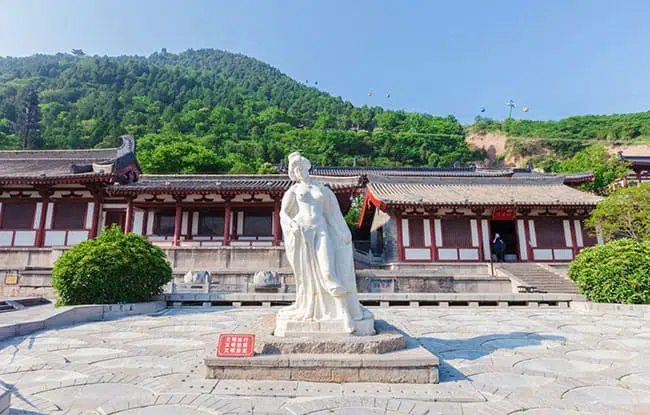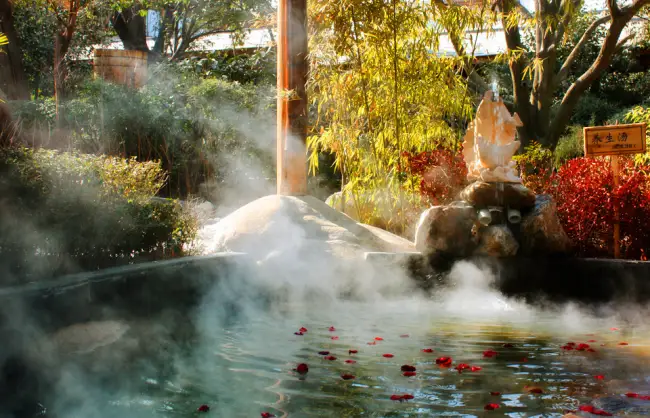Xian Huaqing Palace: A Tang Dynasty Cultural Landmark
In Xian, in April 1982, the ruins of some ancient buildings and hot spring pools were found when the ground for the “Arbor of Imperial Consort” was being prepared for reconstruction. A scientific examination shows that it is the ruin of the former Huaqing Palace of the Tang Dynasty. What is being excavated now is the ruin of the palace and bathing pools located in the southern part of the eastern area of the Tang Huaqing Palace, which used to be a place for the emperor to slay and rake baths when he made his tours here. The bathing pools so far excavated now are the “Pool of Stars,” the “Prince Pool,” the “Lotus Pool” and the “Imperial Consort Pool. ”
Xian Huaqing Palace is best known for the arguably beautiful love story of Tang Emperor Xuanzong and his consort Yang Yuhuan. It is also a interesting place to visit for your Xian travel if you are fascinated by the history of Xi’an or Tang Dynasty.

Huaqing Palace Facts
- In Chinese: 华清宫
- Location: 38 North Huqing Road, Lintong District, Xi’an City
- Opening hours: 7:30-18:00
- Ticket price: CNY 120 per person
- Highlights: the remains of five sets of hot spring pool sites, numerous cultural relics
- Time needed: about 3 hours
- How to get to: Take Subway Line 9, and get off at Huaqing Pool Station Exits B or C, then walk about 3 minutes to the scenic area; take Bus 915, 914, or Tourist Bus Line 5 (Bus No. 306) and get off at Huaqing Pool Station.
Huaqing Palace History & Reconstructions in Different Dynasties
Looking back at the Huaqing Hot Spring in history, it has undergone four times of large constructions. The first time could be dated hack to the Western Zhou Dynasty of over 3,000 years ago. At the time, the King of Zhou built his temporary palaces here, naming them the ” Ligong” in Chinese or the Palaces at Lishan Mountain.
The second time was in the Qin Dynasty. This time, the First Qin Emperor constructed palaces and halls in addition to creating a stone masonry spring pool known as the Lishan Pool.
By the time of the Western Han Dynasty emperor made it a great pleasure to tour in this place, constructing some palaces here, which were known in Chinese also as ” Ligong,” or the palaces for temporary dwellings.
In the Tang Dynasty, the constructions of the “Hot Spring Palace,” or “Wenquangong” firstly took place during the reign of Emperor Taizong. Then, during the reign of Emperor Xuanzong, Li Longji, a significant expansion took place here, with numerous palaces being built across the mountain slopes and surrounding areas. Du Mu, a renowned Tang poet described Huaqing Pool in his poetry to testify to its magnificence, “To take a far view from Chang’an, Mount Li looks like the embroidery, thousands of gates are opened one after the other along hillsides”.
All these pools were built with both solidity and exquisite craftsmanship. The water management systems are especially notable, showcasing advanced technological skills. Simultaneously, city walls were erected around the area. “Wenquangong” was then renamed as “Huaqinggong,” or Huaqing Palace, and the pools within the palace are known as “Huaqingchi,” or Huaqing Hot Spring. It is said that Emperor Xuanzong and his Imperial Consort Yang had often come to stay and play in the Huaqing Hot Spring here, especially during the chilly winters and lingering springs.

The Layout of Huaqing Palace
According to the literature records and the actual field investigation, it is generally known that the scope of Huaqing Palace is: south to the first peak of Li Shanxi Embroidery Ridge (namely Zhoufeng fire platform), north to the North of this county, east to Shiweng Valley (Temple ditch), west to the west of the railway sanatorium Peony ditch.
The Tang Dynasty Huaqing Palace took full advantage of the favorable terrain, making it a sprawling palace complex of rigorous structure and grandeur. The main hall is centered on the hot spring and forms the core of Huaqing Palace. Specifically, it can be divided into royal city area: Eastern district, central district and Western District; Buildings outside the royal city and among the walls; And the palace buildings on the Li Mountain: West Embroidering Ridge and East embroidering Ridge.
Huaqing Palace Heritage Site
The white jade statue of Tang Dynasty Laojun in Huaqing Pond, the Song tablet of Hot spring in Northern Wei Dynasty and the stone carvings of three Taoist priests in Northern Wei Dynasty are all ancient architectural sites. The site’s demarcation range is the Lintong District (previous county) from the Xi’an city’s south to the Beacon Tower, east to the temple ditch, and west to the peony ditch.
Top Scenic Spots in Huaqing Palace
Feishuangdian, or the Flying Frost Hall
Feishuangdian was a favored retreat for Emperor Xuanzong and Yang Guifei (Imperial Consort Yang). The hall is on the opposite side of Nine Dragon Pool, the warm evaporations kept on spiraling up from the pool. In winter, when snow blanketed the area, the cold wind whipped through, the warm evaporations transform snowflakes into frost, creating a enchanting scene before the hall.
Nine Dragon Pool
Found in the west corner of the Nine Dragon Pool is the Stone Boat, on which, as said when the emperor came with his consort, they would take their baths in the Nine Dragon Pool while having relaxation here. At that time, the pool was built of glossy white marbles and the bottom surface of it revealed some discernible patterns of fish, dragon, flowers and birds and the center of the pool was a bright and clear twin-lotuses carved out of a piece of white jade. The wan spring water poured down from above directly onto the lotus. Hence another name for the pool the Lotus Flower Pool.
Imperial Consort Bathing Pool
Built of white jade, it was a special bathing pool for the Imperial Consort Yang. Shaping like a begonia flower, the pistil was chiseled out of a jade piece and the spring water gushed out right from the middle of the stamen.
Drying Hair Pavilion
It is said that when the Imperial Consort Yang Finished her bath, she would come to dry up her hair while enjoying the scenery in this pavilion.

The Suggested Huaqing Palace Traveling Route:
Wangjing Gate → Furong Lake Scenic spot → Xuanjing Hall of Eternal Life → Tang Yutang Ruins Museum → Hot spring ancient source → crabapple Soup → Ring Garden → Zhaoyang Gate
How to Get to Huaqing Palace from Xian
By subway: Take Metro Line 9 and arrive at Huaqingchi Station, exit B and C, and walk to the scenic spot in 3 minutes.
Self-driving: Driving from Xi’an to Huaqing Palace, take the Xilin Expressway and park your car at the Huaqing Palace Scenic Spot parking lot, as directed by the navigation.









